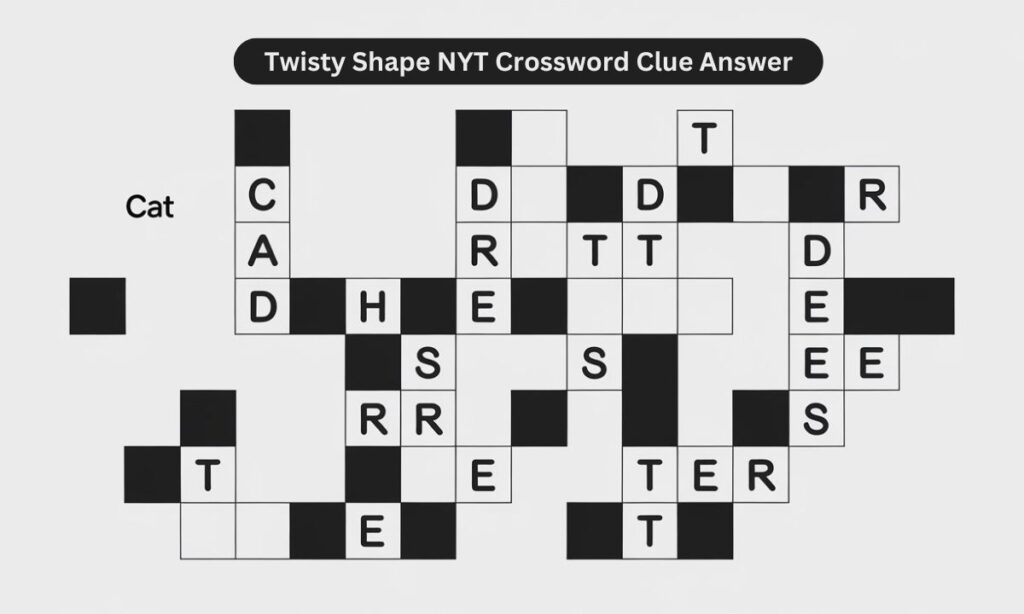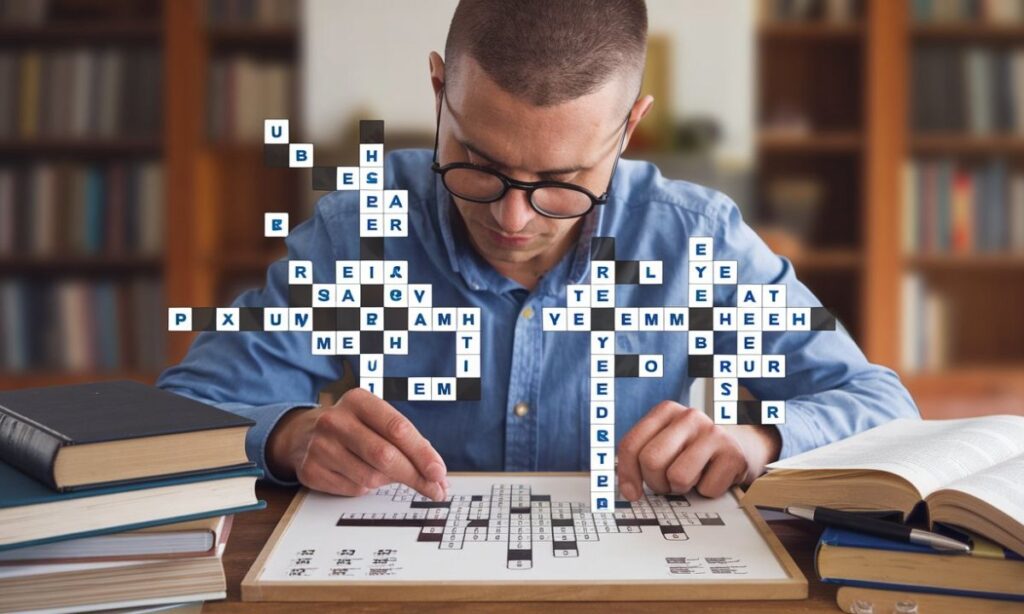In the world of word puzzles, few challenges captivate minds quite like the New York Times crossword. Among its myriad of brain-teasers, the “Twisty Shape NYT” clue has puzzled and delighted solvers in equal measure.
This article dives deep into the heart of this enigmatic crossword clue, offering insights, strategies, and the coveted answer that crossword enthusiasts seek.
The New York Times Crossword: A Cultural Phenomenon
The NYT crossword isn’t just a puzzle; it’s a daily ritual for millions. Since its debut in 1942, it’s evolved into a cultural touchstone, challenging minds and sparking conversations.
From subway commuters to celebrities, this grid of black and white squares unites diverse solvers in a shared intellectual pursuit.
A Brief History of the NYT Crossword
The New York Times crossword puzzle isn’t just a pastime; it’s a cultural institution. Born in the throes of World War II, this daily mental workout has evolved from a simple diversion to a sophisticated challenge that millions eagerly tackle. Its journey from print to pixels mirrors our own cultural shift, with the puzzle now available at our fingertips through apps and online platforms.
“The New York Times crossword is not just a puzzle, it’s a daily ritual for many, a moment of intellectual escape in our busy lives.” – Will Shortz, NYT Crossword Editor
Why Crossword Enthusiasts Love the Challenge
Crossword puzzles, especially those crafted by the NYT, offer more than mere entertainment. They’re a gymnasium for the mind, flexing cognitive muscles and expanding vocabularies.
The sense of accomplishment that comes from cracking a particularly tricky clue is unparalleled. It’s this blend of challenge and reward that keeps solvers coming back day after day, pen (or pixel) in hand.
Decoding “Twisty Shape”: Breaking Down the Clue
“Twisty Shape” exemplifies the clever wordplay NYT crosswords are known for. It’s a clue that requires solvers to think both literally and figuratively.
The phrase might evoke images of spirals or helices, but the true answer often lies in lateral thinking and an understanding of the puzzle’s tricks.
Analyzing the Phrase “Twisty Shape”
The “Twisty Shape NYT” clue is a prime example of the puzzle’s clever wordplay. At first glance, it might evoke images of spirals or helices, but the beauty of crossword clues lies in their potential for misdirection. Let’s break it down:
- Twisty: Implies something that turns or winds
- Shape: A form or figure
Together, these words could describe a variety of objects or concepts. The key is to think both literally and figuratively, as crossword clues often operate on multiple levels.
Common Crossword Tricks to Watch For
Experienced solvers know that the NYT crossword is full of tricks and traps. Here are some to keep in mind:
- Puns and double meanings: Words that can be interpreted in multiple ways
- Abbreviations: Shortened forms of words or phrases
- Pop culture references: Nods to current events, celebrities, or trending topics
- Wordplay: Clever manipulation of language, often involving homophones or anagrams
The Big Reveal: Twisty Shape NYT Crossword Clue Answer

After much anticipation, it’s time to unveil the answer to our twisty conundrum. The solution to the “Twisty Shape NYT” crossword clue is:
SPIRAL
This answer perfectly encapsulates the essence of a twisty shape. A spiral is a curve that winds around a central point, getting progressively closer to or farther from the point as it revolves.
It’s a shape found abundantly in nature, from the spiral of a snail’s shell to the arms of a galaxy.
Why “SPIRAL” Fits the Bill
- Twisty nature: A spiral inherently twists as it curves around its focal point.
- Definitive shape: It has a clear, recognizable form in both two and three dimensions.
- Versatility: The concept of a spiral can be applied to physical objects, mathematical concepts, and even abstract ideas.
Interesting Facts About Spirals
- The Golden Spiral, based on the Golden Ratio, is found in numerous natural phenomena, including the arrangement of seeds in a sunflower.
- Spiral galaxies, like our own Milky Way, make up about two-thirds of all observed galaxies in the universe.
- The Fibonacci spiral, closely related to the Golden Spiral, is often used in art and architecture for its aesthetically pleasing proportions.
Mastering the Art of NYT Crossword Solving
Becoming a crossword whiz takes practice and strategy. Start with easier Monday puzzles and work your way up.
Learn common crosswordese, recognize constructors’ styles, and don’t shy away from using references as you learn. The key is persistence and a willingness to think outside the box.
Tips and Tricks for Crossword Newbies
If you’re new to the world of NYT crosswords, here are some strategies to get you started:
- Start with easier days: Monday and Tuesday puzzles are generally the most straightforward.
- Learn common crosswordese: Familiarize yourself with words that appear frequently in crosswords but rarely in everyday language.
- Practice regularly: The more puzzles you solve, the more patterns you’ll recognize.
- Don’t be afraid to use resources: It’s okay to look up answers when you’re learning. Over time, you’ll need to do this less and less.
Advanced Strategies for Crossword Aficionados
For those looking to take their solving skills to the next level:
- Recognize constructors’ styles: Different puzzle creators have their own quirks and preferences.
- Think outside the box: Sometimes the most obvious answer isn’t the correct one. Be prepared to challenge your assumptions.
- Use cross-references effectively: Clues that reference other parts of the puzzle can be key to solving tricky sections.
The Science Behind Crossword Puzzles

Crosswords aren’t just fun; they’re brain boosters. Studies suggest regular puzzle-solving can improve memory, enhance vocabulary, and potentially delay cognitive decline.
These puzzles engage multiple brain regions, from language centers to problem-solving areas, offering a comprehensive mental workout.
Cognitive Benefits of Solving Crosswords
Engaging with crosswords isn’t just fun; it’s good for your brain. Studies have shown that regular crossword solving can:
- Improve memory
- Enhance pattern recognition skills
- Potentially delay cognitive decline in older adults
How Crosswords Flex Different Parts of Your Brain
| Brain Region | Function | Crossword Relevance |
| Broca’s Area | Language production | Helps formulate potential answers |
| Wernicke’s Area | Language comprehension | Aids in understanding clues |
| Prefrontal Cortex | Problem-solving | Crucial for strategizing and eliminating wrong answers |
| Hippocampus | Memory retrieval | Assists in recalling relevant information |
Beyond the Puzzle: The Crossword Community
The world of crossword solving extends far beyond the grid. Online forums, social media groups, and even in-person events bring together puzzle enthusiasts from all walks of life.
Online Forums and Resources
- Reddit’s r/crossword: A bustling community of solvers sharing tips, tricks, and discussions.
- Crossword solver websites: While useful for beginners, these should be used sparingly to maintain the challenge.
- NYT Crossword Twitter community: Follow @NYTGames for updates, hints, and interactions with fellow solvers.
Crossword Tournaments and Competitions
For those who want to test their skills against others, crossword tournaments offer an exciting challenge. The American Crossword Puzzle Tournament, founded by Will Shortz, is the oldest and most prestigious competition in the country.
Conclusion
The “Twisty Shape NYT” crossword clue, with its answer “SPIRAL,” is just one example of the clever wordplay and mental gymnastics that make the New York Times crossword a beloved daily ritual for many.
Whether you’re a seasoned solver or a curious newcomer, the world of crosswords offers endless opportunities for learning, growth, and pure enjoyment. As you continue your crossword journey, remember that each puzzle is a new adventure.
The next time you encounter a twisty clue, take a moment to appreciate the craft behind it. And who knows? You might just find yourself spiraling down the delightful rabbit hole of crossword enthusiasm.
FAQ’s About NYT Crosswords and Twisty Shapes
How often does “Twisty Shape” appear as a clue?
While specific statistics aren’t available, variations of this clue appear periodically, often with different answers depending on the context.
What’s the hardest day for NYT crosswords?
Saturday puzzles are typically considered the most challenging, with no theme and often featuring the trickiest clues.
Can I access old NYT crosswords?
Yes, NYT Crossword subscribers can access an archive of past puzzles dating back to 1993.
Are there other famous twisty shape clues?
Yes, clues like “Twisted pasta shape” (FUSILLI) or “Twisty turn” (CORKSCREW) are examples of similar themed clues.
How can I improve my crossword-solving speed?
Regular practice, familiarizing yourself with common crossword answers, and studying different clue types can all help improve your solving speed.
What is the answer to the twisty shape in the nyt?
The answer to “Twisty Shape” in the NYT crossword is typically SPIRAL.
What is a twisty shape called?
A twisty shape is often called a spiral, helix, or coil, depending on its specific form.
What is a word for “twisted out of shape”?
A common word for “twisted out of shape” is DISTORTED.
What is a 7 letter word for twist out of shape?
A 7-letter word for “twist out of shape” is CONTORT.
Also Read 👍: Church Of The Highlands Exposed, With Its Many Scandals

Taylor Swift is the founder and lead writer behind the independent blog genrealpro.com










